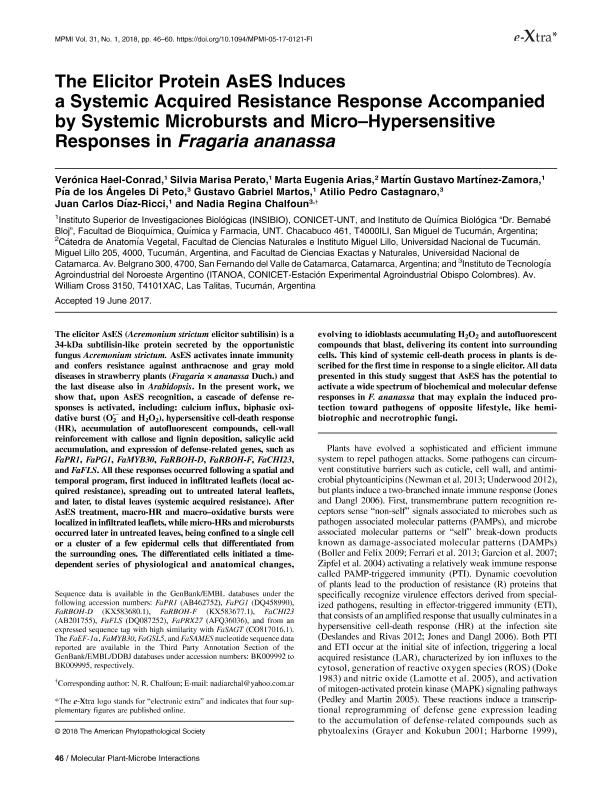Artículo
The elicitor protein AsES induces a systemic acquired resistance response accompanied by systemic microbursts and micro-hypersensitive responses in Fragaria ananassa
Hael Conrad, Verónica ; Perato, Silvia Marisa
; Perato, Silvia Marisa ; Arias, Marta Eugenia; Martinez Zamora, Martin Gustavo
; Arias, Marta Eugenia; Martinez Zamora, Martin Gustavo ; Di Peto, Pía de Los Ángeles
; Di Peto, Pía de Los Ángeles ; Martos, Gustavo Gabriel
; Martos, Gustavo Gabriel ; Castagnaro, Atilio Pedro
; Castagnaro, Atilio Pedro ; Diaz Ricci, Juan Carlos
; Diaz Ricci, Juan Carlos ; Chalfoun, Nadia Regina
; Chalfoun, Nadia Regina
 ; Perato, Silvia Marisa
; Perato, Silvia Marisa ; Arias, Marta Eugenia; Martinez Zamora, Martin Gustavo
; Arias, Marta Eugenia; Martinez Zamora, Martin Gustavo ; Di Peto, Pía de Los Ángeles
; Di Peto, Pía de Los Ángeles ; Martos, Gustavo Gabriel
; Martos, Gustavo Gabriel ; Castagnaro, Atilio Pedro
; Castagnaro, Atilio Pedro ; Diaz Ricci, Juan Carlos
; Diaz Ricci, Juan Carlos ; Chalfoun, Nadia Regina
; Chalfoun, Nadia Regina
Fecha de publicación:
01/2018
Editorial:
American Phytopathological Society
Revista:
Molecular Plant-Microbe Interactions
ISSN:
0894-0282
Idioma:
Inglés
Tipo de recurso:
Artículo publicado
Clasificación temática:
Resumen
The elicitor AsES (Acremonium strictum elicitor subtilisin) is a 34-kDa subtilisin-like protein secreted by the opportunistic fungus Acremonium strictum. AsES activates innate immunity and confers resistance against anthracnose and gray mold diseases in strawberry plants (Fragaria × ananassa Duch.) and the last disease also in Arabidopsis. In the present work, we show that, upon AsES recognition, a cascade of defense responses is activated, including: calcium influx, biphasic oxidative burst (O2·- and H2O2), hypersensitive cell-death response (HR), accumulation of autofluorescent compounds, cell-wall reinforcement with callose and lignin deposition, salicylic acid accumulation, and expression of defense-related genes, such as FaPR1, FaPG1, FaMYB30, FaRBOH-D, FaRBOH-F, FaCHI23, and FaFLS. All these responses occurred following a spatial and temporal program, first induced in infiltrated leaflets (local acquired resistance), spreading out to untreated lateral leaflets, and later, to distal leaves (systemic acquired resistance). After AsES treatment, macro-HR and macro-oxidative bursts were localized in infiltrated leaflets, while micro-HRs and microbursts occurred later in untreated leaves, being confined to a single cell or a cluster of a few epidermal cells that differentiated from the surrounding ones. The differentiated cells initiated a timedependent series of physiological and anatomical changes, evolving to idioblasts accumulating H2O2 and autofluorescent compounds that blast, delivering its content into surrounding cells. This kind of systemic cell-death process in plants is described for the first time in response to a single elicitor. All data presented in this study suggest that AsES has the potential to activate a wide spectrum of biochemical and molecular defense responses in F. ananassa that may explain the induced protection toward pathogens of opposite lifestyle, like hemibiotrophic and necrotrophic fungi.
Archivos asociados
Licencia
Identificadores
Colecciones
Articulos(CCT - NOA SUR)
Articulos de CTRO.CIENTIFICO TECNOL.CONICET - NOA SUR
Articulos de CTRO.CIENTIFICO TECNOL.CONICET - NOA SUR
Articulos(INSIBIO)
Articulos de INST.SUP.DE INVEST.BIOLOGICAS
Articulos de INST.SUP.DE INVEST.BIOLOGICAS
Articulos(ITA-NOA)
Articulos de INST. DE TECNOLOG. AGROINDUST. DEL NOROESTE ARGENTINO
Articulos de INST. DE TECNOLOG. AGROINDUST. DEL NOROESTE ARGENTINO
Citación
Hael Conrad, Verónica; Perato, Silvia Marisa; Arias, Marta Eugenia; Martinez Zamora, Martin Gustavo; Di Peto, Pía de Los Ángeles; et al.; The elicitor protein AsES induces a systemic acquired resistance response accompanied by systemic microbursts and micro-hypersensitive responses in Fragaria ananassa; American Phytopathological Society; Molecular Plant-Microbe Interactions; 31; 1; 1-2018; 46-60
Compartir
Altmétricas



